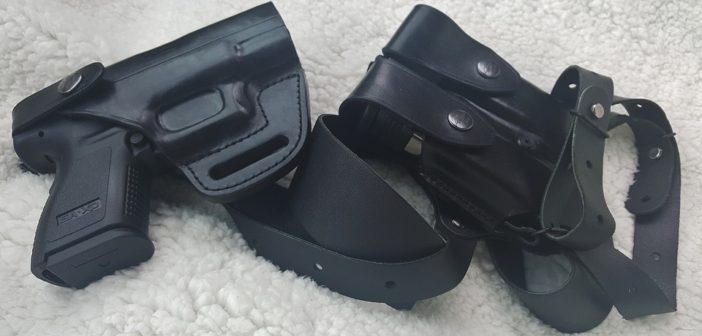When it’s time to select a holster, it’s not unusual to spend lots of time researching the available options. The holster is an important piece of gear that has to both hold and conceal your firearm. It must also be accessible and comfortable to wear with your regular clothes. While you shouldn’t have to spend a fortune on it, it’s also not wise to select one solely based on price. Here are some important things to consider before making your choice.
Materials
The best holster materials are usually leather and molded plastic. While there are some decent holsters made from nylon and synthetic materials, leather and plastic have some specific and distinct advantages.
Leather is clearly the most traditional material. It does require a break-in period, before it begins to stretch. Once it does, it will mold to the firearm, as well as to your body, making the entire set-up more comfortable. If it gets too loose, you can place it in warm water for about 30 seconds, then let it dry.
Thermoplastic holsters (like Kydex) are molded with heat, so you have to be careful where you place them. For example, it’s not advisable to leave them on the dashboard on a hot day. All that aside, they require no break-in period. Since they are created to accommodate specific shapes and sizes, they can grip the triggerguard and other parts far better than any leather holster.
Weapon Retention
Retention can be defined as your holster’s ability to properly contain your firearm. You should be able to move freely in all directions, run, and even jump without your firearm coming loose. On the other hand, retention should not be so tight that you’re unable to draw quickly in an emergency. It helps to have a holster that allows you to adjust the retention, provided you take the time to adjust it on the range. Remember that if you choose a holster with a thumb-break snap, you should practice disengaging it during your natural drawing motion. You don’t want to have to fumble with it at the wrong time.
Common Styles
The most common holster styles are IWB (inside the waistband), OWB (outside the waistband), shoulder, ankle and pocket carry holsters. There are also some more creative and unusual holster solutions out there that deserve mention.
IWB holsters are worn similarly to their OWB counterparts, with their best position dependent on body type and choice of clothing. You’ll need pants that are about 2 inches bigger than what you would normally wear and an undershirt to protect your skin from the gun’s grips. While they’re great in terms of concealability, they can be uncomfortable.
OWB holsters have been around longer than any other variety and can even be worn in a crossdraw position. This is ideal for someone who spends most of their time seated, although it’s a slower position to draw from. If you’re going to use an OWB holster for concealed carry, you’ll need either a jacket or a large shirt to wear over it.
Shoulder holsters are quite comfortable and easy to conceal. When drawing your weapon, you will be crossdrawing from under the opposite arm. If you don’t like wearing baggy shirts to cover waistband holsters, you might find it easier to conceal a small-frame pistol this way. Just remember that when do you put a shirt over it, you’ll have to reach higher for access.
Ankle holsters can be either comfortable or painful, depending on how much padding they come with and how they’re positioned. They’re also slower to draw from, because of the fact that you have to bend down and hike up your pant leg. This can be difficult during a physical fight. However, they’re great at concealing small-framed handguns, provided you can keep your pant leg from riding up.
Pocket holsters offer a safe and secure way to carry a small firearm in a large pocket. If the gun is loose in your pocket, there’s no telling what position it will be in when you reach for it. This can lead to a slow draw or even a negligent discharge. Pocket holsters come with a small tab at the bottom that prevents them from coming out with the firearm as you draw. Remember not to carry anything else in that pocket.
Unusual holsters include thigh holsters, belly bands, shirts and jackets with hidden pockets, underwear holsters, clips and fanny packs. The idea behind these is that sometimes conventional holster designs will not suffice, depending on the situation. If you find that conditions prevent you from carrying in your normal way, you might want to look into these more exotic solutions.
Comfort
Never underestimate the importance of comfort when carrying a handgun. It goes without saying that virtually any firearm you carry can get in the way, at times. However, you don’t need the entire world wondering why you’re constantly squirming and fidgeting. A quality holster should not require constant adjustment, whether inside or outside of your clothes.
Budget
Finally, you have to be able to afford the right holster. As with any other product, you’re the only one who knows what you can afford. Just remember that the best quality holster, or even the best one for you, isn’t always going to be the most expensive one in the store. That’s why it’s important to try many different ones in various price ranges to see where your needs are, as compared to your budget. If it turns out that the best one is a bit pricey, consider cutting back on something less important than the holster you’re trusting with your life.
Holsters come in many styles and sizes, but it’s possible to narrow the field by taking into consideration the factors mentioned above. Remember that carrying and being able to access your firearm in an emergency is often a matter of life and death. With that said, you should choose your holster with just as much care as the weapon it holds.




